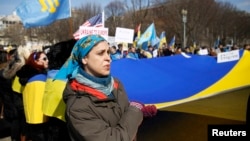The Syrian crisis may lead to increased U.S. media interest in Ukraine, according to some experts, because readers will be interested in whether Ukraine can be sacrificed as part of a U.S.-Russia deal on Syria.
When the Russian invasion of Ukraine first occurred in February-March 2014, almost all U.S. media covered the issue. But the situation changed.
“For the past few months, coverage has been crowded out by Iran, now Syria, and has been limited to the main news outlets, especially The Wall Street Journal and The New York Times,” said David Kramer, senior director for human rights and democracy at the McCain Institute.
“Since the Donbas ceasefire is working, there's no bloodshed to report for now,” Matthew Rojansky, director of the Kennan Institute at the Woodrow Wilson International Center for Scholars, explained.
Now the stories are mainly about corruption in Ukraine and how its government is failing to change anything.
“On one hand, more nuanced coverage; on another, more sporadic and pessimistic,” said Maria Haigh, associate professor of the School of Information Studies at the University of Wisconsin Milwaukee.
However, most coverage is repetitive.
“Either it is simply a reprint of a ‘wire’ article from AP, AFP, Reuters, etc. or it's a near duplicate of the coverage by one of the major papers – The New York Times, The Washington Post and The Wall Street Journal,” Rojansky said. “Likewise, local TV stations just rebroadcast the reports filed by national networks or give short 30-second updates using wire footage.”
Robert Orttung, associate research professor of international affairs at George Washington University and Assistant Director of the Institute for European, Russian and Eurasian Studies, pointed out that just a few national media and regional papers like the Los Angeles Times and San Francisco Chronicle cover Ukraine.
“There is also good, though infrequent, coverage of Ukraine in new online sources like Vice.com, Mashable, Daily Beast,” he said.
Difference in media coverage
U.S. and Russian media differ in their Ukraine coverage.
Russian media go deeply into many topics, whereas U.S. media usually adopt one or two major themes and repeat them constantly in their coverage.
“For example, on Ukraine the themes have been the East vs. West conflict, and Putin the Hollywood-type bad guy,” Rojansky said. “If a story doesn't fit into this rubric – for example one about Ukraine's complex internal politics, society, national-identity issues, or reforms – then it often is rejected by editors.”
Kramer thinks that U.S. media coverage is more objective than Russian.
“It is vastly different from Russian media coverage for the simple reason that it's fact-based reporting, whereas Russian coverage is propaganda,” he said. Most Russian mainstream media are state-controlled, whereas most U.S. mainstream media are businesses.
Orttung said that U.S. media typically try to present two sides of the story, so if an expert says something critical about President Putin, they will find someone to say something supportive of him.
At the same time, he believes that this advantage can also be a problem.
“The result is that the reader does not really understand what is happening,” he said. “This is a big problem now for lots of topics, not just Ukraine, Russia and Putin.”
Another problem of U.S. media is sources for their stories. “Only big outlets have correspondents abroad who can be sent to Ukraine when a story breaks,” Kramer said. The Wall Street Journal and Vice.com have their correspondents in Ukraine, while The New York Times and The Washington Post rely on their Moscow correspondents.
“I rely now only on sources that do have their correspondents in Ukraine: The Economist, Financial Times (British agencies), The New York Times (American), dailybeast.com,” Haigh said.
Others use news agencies as their sources, whereas most Russian mainstream media have their own correspondents in the Donbas region and in Crimea.
“During Euromaidan events and Russian annexation of Crimea, many U.S. media as well as German ones relied on Russian media coverage, for example, on RT TV channel,” Alina Polyakova, associate director of Ukraine in Europe Initiative of the Atlantic Council, explained. “MH17 tragic events were the change point.”
“At that time, in July 2014, many U.S. media sent their correspondents to Ukraine and it helped them to understand the real situation there,” Polyakova said.
According to her words, in April-July 2014, both U.S. and Russian media called armed people in the East of Ukraine “Ukrainian separatists” but since the second part of July 2014 U.S. media started calling them “pro-Russian separatists.”
“And now some mainstream media call them ‘separatist-backed Russian forces’,” Polyakova says.
U.S. and Russian media also have other differences in terminology. Russian media call Crimea “a Russian territory,” whereas U.S. ones call it “an annexed territory of Ukraine” according to international laws.
Evoking interest
U.S. journalists could draw more attention to Ukrainian issues, experts believe.
According to Kramer, Ukraine can be interesting as part of a larger story about how President Putin is a threat to his own people, his neighbors, and now in the Middle East.
But he says it is important not to oversimplify the story. “If you reduce it to a story about good vs. evil, democracy vs. dictatorship, or Russia vs. the West, this story doesn't have much long-term currency,” Rojansky says.
“Ukraine has lots of artists, tech companies – the founder of Whatsapp is Ukrainian! – writers, musicians, recipes, food products, WWII history, etc. that are mostly unknown in the U.S.,” Orttung explains.
Therefore, while Ukraine might not be able to compete with Syria for attention on the front pages of newspapers, it could reach many smaller niche audiences in the United States.
